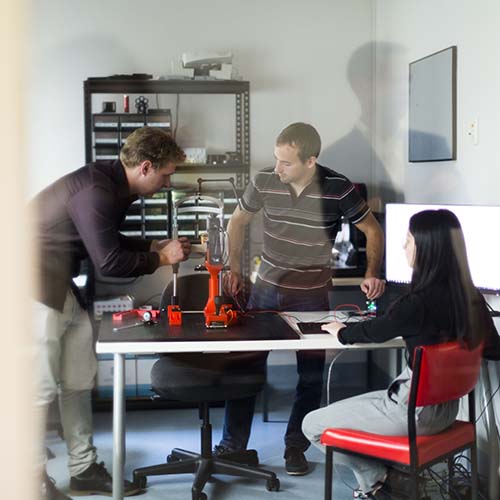This website uses cookies so that we can provide you with the best user experience possible. Cookie information is stored in your browser and performs functions such as recognising you when you return to our website and helping our team to understand which sections of the website you find most interesting and useful.
News
Medical Research Future Fund boost to take satellite technology from space to the eye clinic
The developers of a simple eye test to detect signs of Alzheimer’s disease have won funding to help take their technology from the lab to the eye clinic.
Enlighten Imaging, an Australian start-up company incubated at the Centre for Eye Research Australia, is one of the latest recipients of the Australian Government’s Medical Research Future Fund support under the BioMedTech Horizons 2.0 program delivered by MTPConnect.
The team, which includes Associate Professor Peter van Wijngaarden and Senior Research Fellow Dr Xavier Hadoux, developed a technology similar to that used in NASA satellites to scan the retina for signs of brain and eye diseases. It will increase access to tests, which are currently not available in eye clinics, for these conditions.
Funding from BioMedTech Horizons – along with support from the National Foundation for Medical Research and Innovation– will enable the team to start the medical device development journey and take this technology, successfully utilised in research trials, to the eye clinic.
Associate Professor van Wijngaarden said the funding was an important step in helping the team turn their research into a real-world outcome that would benefit patients.
“We are grateful for this important funding that will help us take our ‘proof-of-concept’ technology and prototype camera to develop a new scanning device which will benefit patients, eye care professionals and the broader health system,’’ he said.

The team has developed a technology similar to that used in NASA satellites to scan the retina for signs of brain and eye diseases.
The BioMedTech Horizons program is a funding initiative to support innovative collaborative health technologies, drive discoveries towards proof-of-concept and commercialisation that address key health challenges as well as maximise entrepreneurship and idea potential.
Associate Professor van Wijngaarden said so far, the team had used an expensive research camera for its studies, but would now develop a less expensive, portable model that could eventually be used by an optometrist.
“We want to make our technology available to those at the frontline of eye care and we believe hyperspectral imaging has the ability to provide new insights into eye and brain health.’’
Research recently published in Nature Communications showed that the eye test accurately identified study volunteers who have brain changes that suggest of Alzheimer’s disease.
It’s now being trialled in a larger study in collaboration with the Healthy Brain Project at the Florey Institute of Neuroscience and Mental Health. The aim of this study is to assess whether the eye test can detect people at risk of the disease, up to 20 years before the onset of symptoms.
“We are at a new frontier in eye imaging,” Associate Professor van Wijngaarden said.
“The development of a simple test to identify people at risk of Alzheimer’s disease could be tremendously important, as it would enable trials of new early stage treatments to prevent or slow the disease.’’

